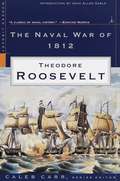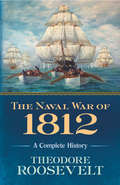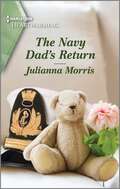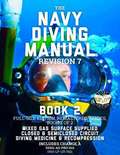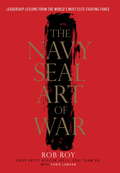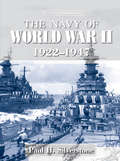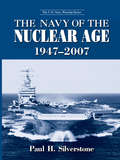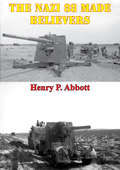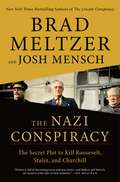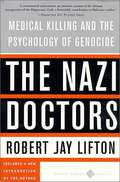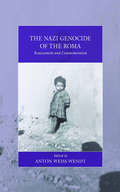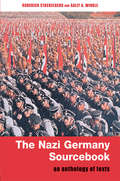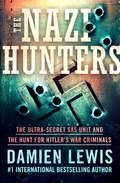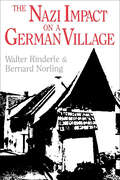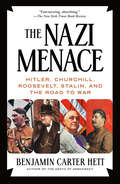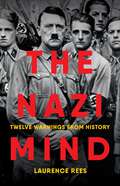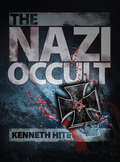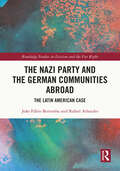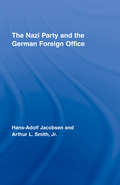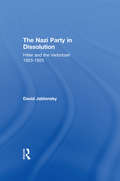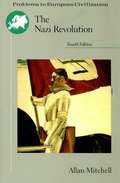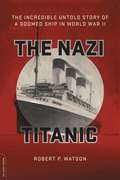- Table View
- List View
The Naval War of 1812 (Modern Library War)
by Theodore RooseveltPublished when Theodore Roosevelt was only twenty-three years old, The Naval War of 1812 was immediately hailed as a literary and scholarly triumph, and it is still considered the definitive book on the subject. It caused considerable controversy for its bold refutation of earlier accounts of the war, but its brilliant analysis and balanced tone left critics floundering, changed the course of U.S. military history by renewing interest in our obsolete forces, and set the young author and political hopeful on a path to greatness. Roosevelt's inimitable style and robust narrative make The Naval War of 1812 enthralling, illuminating, and utterly essential to every armchair historian. The books in the Modern Library War series have been chosen by series editor Caleb Carr according to the significance of their subject matter, their contribution to the fieldof military history, and their literary merit.
The Naval War of 1812: A Complete History
by Theodore RooseveltAlthough only 23 years old at the time of publication, Theodore Roosevelt made his mark as a military scholar with this detailed analysis of naval combat between the United States and Great Britain from 1812–15. Engagingly written and comprehensively researched, The Naval War of 1812 exercised considerable influence on the formation of the modern American Navy and remains a cornerstone work in its field.Drawing upon official documents, letters, and histories, Roosevelt portrays the political and social atmosphere in the United States and Great Britain prior to the war, taking particular note of America's unpreparedness. He then presents a balanced year-by-year chronicle of the war's progression on the Atlantic Ocean and the American lakes. Unlike prior histories, Roosevelt's account offers impartial assessments of the relative strengths and weaknesses of both sides. Four years after publication, the U.S. Navy ordered that a copy be placed on every ship, and it remains standard reading at the Naval Academy. The book contributed to Roosevelt's appointment as Assistant Secretary of the Navy and his role in the navy's development and modernization, resulting in a significant step toward America's rise as a world power.
The Navy Dad's Return: A Clean and Uplifting Romance (Big Sky Navy Heroes #3)
by Julianna MorrisCould returning home…Be where love begins? Widower Wyatt Maxwell&’s daughter is his world. So instead of deploying, the navy officer resigns and returns to the family ranch, despite the tensions and hometown matchmakers waiting for him. Thankfully, his outspoken new nanny, Katrina Tapson, only wants lodging for herself and her nephew and isn't interested in romance. But when Katrina proves the calm to his storm, will Wyatt decide loving again is worth the risk?From Harlequin Heartwarming: Wholesome stories of love, compassion and belonging.Big Sky Navy HeroesBook 1: The Cowboy SEAL's ChallengeBook 2: The SEAL's Christmas DilemmaBook 3: The Navy Dad's Return
The Navy Diving Manual -: Mixed Gas Surface Supplied, Closed & Semiclosed Circuit, Diving Medicine & Recompression (Carlile Military Library #Volume 47)
by Carlile Media Us NavySince this manual will form the technical basis of many subsequent instructions or directives, it utilizes the standard Navy syntax as pertains to permissive, advisory, and mandatory language. This is done to facilitate the use of the information provided herein as a reference for issuing Fleet Directives
The Navy In Battle [Illustrated Edition]
by Arthur Joseph Hungerford PollenContains 10 maps, diagrams and illustrations.Arthur Pollen, was a famous British naval historian and inventor of naval warfare equipment, particularly noted for his computer based fire-control system; as with many scientists on the outside of the Admiralty he met with resistance. The British naval establishment were none too fond of Pollen's biting magazine articles on their conduct of the war; Pollen wrote extensively on Naval matters during the period of the First World War and also penned this volume entitled "The Navy in Battle". In keeping with his disestablishment line, he was very critical of the handling of the Navy and covers herein the submarine menace, the battle of the Falkland Islands, the engagement at Helgoland Bight and the Battle of Jutland. Although he saluted the heroism of the Royal Navy on the seas in general he pulled no punches on what he saw as fundamental issues of handling of the war effort, indeed he aimed particular criticism at Admiral Jellicoe and his actions at the battle of Jutland.Refreshingly an unjingoistic work free form many of the prejudices of British naval works on the First World War.
The Navy SEAL Art of War
by Rob Roy Chris LawsonIn a groundbreaking, narrative-driven book for businesses, managers (and those who aspire to the managerial ranks), and entrepreneurs, a veteran Navy SEAL Chief Petty Officer shows how the skills that enable SEAL teams to achieve the impossible in the battlefield can help business executives and career-minded individuals make better decisions and get the best out of their teams. Anyone can make good decisions when everything is in their favor. But in life, as in war, it's in chaotic, challenging times that genuine leaders distinguish themselves. As a Navy SEAL Chief Petty Officer, Rob Roy learned this lesson over twenty-five years of combat, in which the difference between life and death was his team's ability to decode complex environments, take decisive action, and seize opportunities when they presented themselves. In The Navy SEAL Art of War, Roy decodes the leadership lessons of the battlefield for today's business leaders and individuals: how to make good decisions under pressure, how to utilize and leverage the strengths of others while minimizing the weaknesses of the individual or team, and how to act instead of react, anticipating events despite having minimal information and effectively communicating tasks and priorities. Illustrated with countless stories from the front lines, and featuring unprecedented exercises and drills from the SEALs' training program, The Navy SEAL Art of War is destined to take its place aside It's Your Ship as a bestselling business classic.
The Navy SEAL Art of War: Leadership Lessons from the World's Most Elite Fighting Force
by Rob Roy Chris LawsonIn a groundbreaking, narrative-driven book for businesses, managers (and those who aspire to the managerial ranks), and entrepreneurs, a veteran Navy SEAL Chief Petty Officer shows how the skills that enable SEAL teams to achieve the impossible in the battlefield can help business executives and career-minded individuals make better decisions and get the best out of their teams. Anyone can make good decisions when everything is in their favor. But in life, as in war, it’s in chaotic, challenging times that genuine leaders distinguish themselves. As a Navy SEAL Chief Petty Officer, Rob Roy learned this lesson over twenty-five years of combat, in which the difference between life and death was his team’s ability to decode complex environments, take decisive action, and seize opportunities when they presented themselves. In The Navy SEAL Art of War, Roy decodes the leadership lessons of the battlefield for today’s business leaders and individuals: how to make good decisions under pressure, how to utilize and leverage the strengths of others while minimizing the weaknesses of the individual or team, and how to act instead of react, anticipating events despite having minimal information and effectively communicating tasks and priorities. Illustrated with countless stories from the front lines, and featuring unprecedented exercises and drills from the SEALs’ training program, The Navy SEAL Art of War is destined to take its place aside It’s Your Ship as a bestselling business classic.
The Navy SEAL's Rescue
by Jo LeighHow do you save a hero?Workaholic Cricket Shaw is a darn good lawyer—until a controversial case compromises both her ethics and her career. A long weekend in Temptation Bay, Rhode Island, for her high school reunion is the perfect escape. Sand between her toes, the sun on her skin…and a ruggedly mysterious former navy SEAL.Except Wyatt Covack is much more than Cricket ever imagined. He’s still tormented by the lives he was responsible for and lost. The connection between them seems to take on a life of its own, a current that resists all logic. But the only way Cricket can save her SEAL is by letting go of the life she’s fought for…
The Navy of World War II, 1922-1947 (The U.S. Navy Warship Series)
by Paul SilverstoneThe Navy of World War II, 1922-1946 comprehensively covers the vessels that defined this momentous 24-year period in U.S. naval history. Beginning with the lean, pared-down navy created by the treaty at the Washington Naval Conference, and ending with the massive, awe-inspiring fleets that led the Allies to victory in the Second World War, the fourth volume in the celebrated U.S. Navy Warship series presents a detailed guide to all the warships that exhibited the might of the U.S. Navy to the fullest. Showcasing all the ships—both the famous and the often overlooked-that propelled the U.S Navy to prominence in the first half of the twentieth century, The Navy of World War II catalogues all the warships from this era, including those that did battle in the European, Mediterranean, and Pacific Theaters from 1941-1946. From the fleet attacked at Pearl Harbor, to those that fought valiantly in the Battle of the Guadalcanal, to the official surrender of the Japanese on the deck of the USS Missouri, this latest volume is the definitive guide to the warships that defined this pivotal period in U.S. naval history. Each volume in the U.S. Navy Warship series represents the most meticulous scholarship for its particular era, providing an authoritative account of every ship in the history of the U. S. Navy from its first incarnation as the Continental Navy to its present position as one of the world’s most formidable naval superpowers. Featuring convenient, easy-to-read tabular lists, every book in the series includes an abundance of illustrations, some never before published, along with figures for actions fought, damages sustained, casualties suffered, prizes taken, and ships sunk, ultimately making the series an indispensable reference tool for maritime buffs and military historians alike. A further article about Paul Silverstone and the Navy Warships series can be found at: http://www.thejc.com/home.aspx?ParentId=m11s18s180&SecId=180&AId=58892&ATypeId=1
The Navy of the Nuclear Age, 1947-2007 (The U.S. Navy Warship Series)
by Paul SilverstoneThe Navy of the Nuclear Age, 1947-2007, the fifth volume in the monumental U.S. Navy Warship series, presents an all-inclusive compendium of the ships that served in the U.S. Navy from the Cold War up through the present day. Featuring radical new developments in warships such as nuclear-powered submarines and carriers equipped with ballistic missiles, the post-World War II period was one of unprecedented technological growth for the U.S. Navy. The Navy of the Nuclear Age contains specifications and illustrations for all the ships and submarines that have helped the U.S. to achieve its present-day status as the country with the world’s largest and most powerful navy. A further article about Paul Silverstone and the Navy Warships series can be found at: http://www.thejc.com/home.aspxParentId=m11s18s180&SecId=180&AId=58892&ATypeId=1
The Nazi 88 Made Believers
by Henry P. AbbottMajor Harry Abbott wrote this book of his experiences as the military chaplain of Combat Command B of the 13th Armored Regiment of the 1st Armored Division during the North African campaign soon after returning Stateside. He and his fellow chaplains made ceaseless efforts to care for the spiritual and physical needs of the men in their charge. He was frequently called upon to tend to the sick and wounded, he attested to the tremendous courage displayed by the GIs of his unit as they grappled with the veteran Afrika Korps in North Africa. As alluded to in the title many of his charges faced their religious decisions differently under the fired of the deadly German 88 anti-tank gun; he assiduously noted that "there are no atheists in foxholes." Also in charge of the burial parties sent to ensure the proper respect for the fallen, he describes this lesser known part of the US military effort. Illustrated throughout with his own photographs.
The Nazi Conspiracy: The Secret Plot to Kill Roosevelt, Stalin, and Churchill
by Brad Meltzer Josh MenschINSTANT NEW YORK TIMES BESTSELLER"An absolute home run! You will never look at WWII the same way again." —Brad Thor, #1 bestselling author"Meltzer and Mensch are masters." —Jon Meacham, author The Soul of America"A true story that reads like a thriller." —Alexander S. Vindman, LT. Col., U.S. Army (Ret.)"An outstanding and memorable reading experience....a true page-turner from beginning to end." —Bookreporter.comFrom the New York Times bestselling authors of The First Conspiracy and The Lincoln Conspiracy comes the little-known true story of a Nazi plot to kill FDR, Joseph Stalin, and Winston Churchill at the height of World War II.In 1943, as the war against Nazi Germany raged abroad, President Franklin Roosevelt had a critical goal: a face-to-face sit-down with his allies Joseph Stalin and Winston Churchill. This first-ever meeting of the Big Three in Tehran, Iran, would decide some of the most crucial strategic details of the war. Yet when the Nazis found out about the meeting, their own secret plan took shape—an assassination plot that would’ve changed history.A true story filled with daring rescues, body doubles, and political intrigue, The Nazi Conspiracy details FDR’s pivotal meeting in Tehran and the deadly Nazi plot against the heads of state of the three major Allied powers who attended it.With all the hallmarks of a Brad Meltzer and Josh Mensch page-turner, The Nazi Conspiracy explores the great political minds of the twentieth century, investigating the pivotal years of the war in gripping detail. This meeting of the Big Three changed the course of World War II. Here’s the inside story of how it almost led to a world-shattering disaster.
The Nazi Doctors: Medical Killing and the Psychology of Genocide
by Robert LiftonIn his most powerful and important book, renowned psychiatrist Robert Jay Lifton presents a brilliant analysis of the crucial role that German doctors played in the Nazi genocide. Now updated with a new preface, The Nazi Doctors remains the definitive work on the Nazi medical atrocities, a chilling exposé of the banality of evil at its epitome, and a sobering reminder of the darkest side of human nature.
The Nazi Genocide of the Roma
by Anton Weiss-WendtUsing the framework of genocide, this volume analyzes the patterns of persecution of the Roma in Nazi-dominated Europe. Detailed case studies of France, Austria, Romania, Croatia, Ukraine, and Russia generate a critical mass of evidence that indicates criminal intent on the part of the Nazi regime to destroy the Roma as a distinct group. Other chapters examine the failure of the West German State to deliver justice, the Romani collective memory of the genocide, and the current political and historical debates. As this revealing volume shows, however inconsistent or geographically limited, over time, the mass murder acquired a systematic character and came to include ever larger segments of the Romani population regardless of the social status of individual members of the community.
The Nazi Germany Sourcebook: An Anthology of Texts
by Roderick Stackelberg Sally A. WinkleThe Nazi Germany Sourcebook is an exciting new collection of documents on the origins, rise, course and consequences of National Socialism, the Third Reich, the Second World War, and the Holocaust. Packed full of both official and private papers from the perspectives of perpetrators and victims, these sources offer a revealing insight into why Nazism came into being, its extraordinary popularity in the 1930s, how it affected the lives of people, and what it means to us today. This carefully edited series of 148 documents, drawn from 1850 to 2000, covers the pre-history and aftermath of Nazism: * the ideological roots of Nazism, and the First World War* the Weimar Republic* the consolidation of Nazi power* Hitler's motives, aims and preparation for war* the Second World War* the Holocaust* the Cold War and recent historical debates. The Nazi Germany Sourcebook focuses on key areas of study, helping students to understand and critically evaluate this extraordinary historical episode:
The Nazi Hunters: The Ultra-Secret SAS Unit and the Hunt for Hitler's War Criminals
by Damien LewisThe gripping &“untold story&” of the Secret Hunters, deep-cover British special forces who pursued Nazi fugitives from justice after World War II (Daily Mail). In the late summer of 1944, eighty British Special Air Service (SAS) soldiers undertook a covert commando raid, parachuting behind enemy lines into the Vosges Mountains in occupied France to sabotage Nazi-held roads, railways, and ammo dumps, and assassinate high-ranking German officers, undermining the final stand of Hitler&’s Third Reich. Despite their successes, more than half the men were captured, tortured, and executed. Although the SAS was officially dissolved when the war ended, a top-secret black ops unit was formed, under Churchill&’s personal command, to hunt down the SS commanders who had murdered their special forces comrades, as well as war criminals from concentration camps who had eluded the Nuremberg trials. Under the cover of full deniability, &“The Secret Hunters&” waged a covert war of justice and retribution—uncovering the full horror of Hitler&’s regime as well as dark secrets of Stalin&’s Russia and the growing threat of what would become the Cold War. Finally revealing the fascinating details of the secret postwar mission that became a central part of the SAS&’s founding legend, Damien Lewis &“delves into some of the darkest days of the regiment&’s history to tell a story of tragedy, valor and revenge . . . [a] remarkable story&” (War History Online).
The Nazi Impact on a German Village
by Bernard Norling Walter Rinderle“A vivid & sensitive portrait of a small, tradition-bound community coming to terms with modernity under the most adverse of conditions.” —Observer ReviewMany scholars have tried to assess Adolf Hitler’s influence on the German people, usually focusing on university towns and industrial communities, most of them predominately Protestant or religiously mixed. This work by Walter Rinderle and Bernard Norling, however, deals with the impact of the Nazis on Oberschopfheim, a small, rural, overwhelmingly Catholic village in Baden-Wuerttemberg in southwestern Germany.This incisively written book raises fundamental questions about the nature of the Third Reich. The authors portray the Nazi regime as considerably less “totalitarian” than is commonly assumed, hardly an exemplar of the efficiency for which Germany is known, and neither revered nor condemned by most of its inhabitants. The authors suggest that Oberschopfheim merely accepted Nazi rule with the same resignation with which so many ordinary people have regarded their governments throughout history.Based on village and county records and on the direct testimony of Oberschopfheimers, this book will interest anyone concerned with contemporary Germany as a growing economic power and will appeal to the descendants of German immigrants to the United States because of its depiction of several generations of life in a German village.“An excellent study. Describes in rich detail the political, economic, and social structures of a village in southwestern Germany from the turn of the century to the present.” —Publishers Weekly“A lively, informative treatise that puts a human face on history.” —South Bend Tribune“This very readable story emphasizes continuities within change in German historical development during the twentieth century.” —American Historical Review
The Nazi Menace: Hitler, Churchill, Roosevelt, Stalin, and the Road to War
by Benjamin Carter HettA panoramic narrative of the years leading up to the Second World War—a tale of democratic crisis, racial conflict, and a belated recognition of evil, with profound resonance for our own time.Berlin, November 1937. Adolf Hitler meets with his military commanders to impress upon them the urgent necessity for a war of aggression in eastern Europe. Some generals are unnerved by the Führer’s grandiose plan, but these dissenters are silenced one by one, setting in motion events that will culminate in the most calamitous war in history.Benjamin Carter Hett takes us behind the scenes in Berlin, London, Moscow, and Washington, revealing the unsettled politics within each country in the wake of the German dictator’s growing provocations. He reveals the fitful path by which anti-Nazi forces inside and outside Germany came to understand Hitler’s true menace to European civilization and learned to oppose him, painting a sweeping portrait of governments under siege, as larger-than-life figures struggled to turn events to their advantage. As in The Death of Democracy, his acclaimed history of the fall of the Weimar Republic, Hett draws on original sources and newly released documents to show how these long-ago conflicts have unexpected resonances in our own time. To read The Nazi Menace is to see past and present in a new and unnerving light.
The Nazi Mind: Twelve Warnings from History
by Laurence ReesFrom an award-winning historian, a "compelling and frankly terrifying" (Telegraph) analysis of the rise of Nazi extremism, how such thinking gained popularity, and why it is vital to fight burgeoning extremist movements today How could the SS have committed the crimes they did? How were the killers who shot Jews at close quarters able to perpetrate this horror? Why did commandants of concentration and death camps willingly—and often enthusiastically—oversee mass murder? How could ordinary Germans have tolerated the removal of the Jews? In The Nazi Mind, bestselling historian Laurence Rees seeks answers to some of the most perplexing questions surrounding the Second World War and the Holocaust. Ultimately, he delves into the darkness to explain how and why these people were capable of committing the worst crimes in the history of the world. From the fringe politics of the 1920s to the electoral triumph and mass mobilization of the 1930s, and from the Holocaust through to the regime&’s eventual demise, Rees charts the rise and fall of Nazi mentalities—including the conditions that allowed such a violent ideology to flourish and the sophisticated propaganda effort that sustained it. Using previously unpublished testimony from former Nazis and those who grew up in the Nazi system, and in-depth insights based on the latest research of psychologists, The Nazi Mind brings fresh understanding to one of the most appalling regimes in history.
The Nazi Occult
by Kenneth Hite Darren TanIn the dark dungeons beneath Nazi Germany, teams of occult experts delved into ancient and forbidden lore, searching for lost secrets of power. Ordered by Hitler to discover new weapons that he could unleash on his enemies, the occultists experimented with dark magics, mystical artifacts, and creatures thought only to exist in nightmare. This book tells the complete history of the Nazi occult programs, from their foundations in Hitler's early esoteric studies and the Nazi quests for the Ark of the Covenant, the Spear of Destiny, and the Holy Grail, through their experiments with lycanthrope and zero-point energy. It also includes sections on the shadow war fought in the dying days of the Reich as the Nazis sought to stave off defeat through pacts with diabolic entities, attempts to save the Fuhrer's brain, and the deployment of the strange flying saucers that battled to save the final Nazi stronghold in the Antarctic. For years, the Allied governments worked to keep this information from reaching the public, and sought to discredit those few who dared to seek the truth. Now, using a combination of photography and artwork reconstructions, the true story of the most secret battles of World War II can finally be told.
The Nazi Party and the German Communities Abroad: The Latin American Case (Routledge Studies in Fascism and the Far Right)
by João Fábio Bertonha Rafael AthaidesThe Nazi Party and the German Communities Abroad examines the German Nazi Party’s actions around the world in the 1930s and 1940s. The book particularly focuses in on the formation and development of the Auslandsorganization der NSDAP (AO) (Nazi Party/Foreign Organization), the party branch charged with the task of connecting with foreign fascist movements and, especially, with Germans living abroad. The authors follow the creation of the AO and its development in Germany, along with its actions throughout the world, including Europe, Asia, Africa and North America, before finally focusing on Latin America. The Latin American case is then presented in both general and particular aspects, including countries such as Argentina, Chile, Brazil, Mexico and Colombia. The study draws on many primary sources and is extensively referenced; an index with seven hundred references related to the action of Nazism in the American continent is presented, including the American and Canadian cases. This volume will be of interest to researchers of the history of Nazism and Latin America.
The Nazi Party and the German Foreign Office (Routledge Studies in Modern European History #Vol. 11)
by Hans-Adolph Jacobsen Arthur L. Smith Jr.The Nazi Party and the German Foreign Office explores the struggle between entrenched diplomats in the Foreign Office and Party loyalists, who presumed that with the assumption of power in 1933 total state control was theirs.
The Nazi Party in Dissolution: Hitler and the Verbotzeit 1923-25
by David JablonskyThis book examines the effect the Verbotzeit had on the leadership structure and on the consequent position of the party within the völkisch movement. Looking primarily at Bavaria and North Germany it examines the failed attempts that were made to prevent Hitler from filling the leadership void within both the NSDAP (the National Socialist German Workers' Party) and the völkisch movement.
The Nazi Revolution: Hitler's Dictatorship and the German Nation (Fourth Edition)
by Allan MitchellThis anthology explores the Nazi movement in the context of German history and society.
The Nazi Titanic: The Incredible Untold Story of a Doomed Ship in World War II
by Robert P. WatsonBuilt in 1927, the German ocean liner SS Cap Arcona was the greatest ship since the RMS Titanic and one of the most celebrated luxury liners in the world. When the Nazis seized control in Germany, she was stripped down for use as a floating barracks and troop transport. Later, during the war, Hitler's minister, Joseph Goebbels, cast her as the "star" in his epic propaganda film about the sinking of the legendary Titanic.Following the film's enormous failure, the German navy used the Cap Arcona to transport German soldiers and civilians across the Baltic, away from the Red Army's advance. In the Third Reich's final days, the ill-fated ship was packed with thousands of concentration camp prisoners. Without adequate water, food, or sanitary facilities, the prisoners suffered as they waited for the end of the war. Just days before Germany surrendered, the Cap Arconawas mistakenly bombed by the British Royal Air Force, and nearly all of the prisoners were killed in the last major tragedy of the Holocaust and one of history's worst maritime disasters.Although the British government sealed many documents pertaining to the ship's sinking, Robert P. Watson has unearthed forgotten records, conducted many interviews, and used over 100 sources, including diaries and oral histories, to expose this story. As a result, The Nazi Titanic is a riveting and astonishing account of an enigmatic ship that played a devastating role in World War II and the Holocaust.Visit NaziTitanic.com
